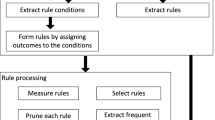Abstract
Tree-basedmodels provide an appealing alternative to conventional models formany reasons. They are more readily interpretable, can handle both continuous and categorical covariates, can accommodate data with missing values, provide an implicit variable selection, and model interactionswell. Most frequently used tree-basedmodels are classification, regression, and survival trees. Visualization is important in conjunction with treemodels because in their graphical formthey are easily interpretable even without special knowledge. Interpretation of decision trees displayed as a hierarchy of decision rules is highly intuitive.
Access this chapter
Tax calculation will be finalised at checkout
Purchases are for personal use only
Preview
Unable to display preview. Download preview PDF.
Similar content being viewed by others
References
Breiman, L. (1996). Bagging predictors, Machine Learn 24(2):123–140.
Breiman, L. (1999). Random forests – random features, Technical Report TR567, University of California-Berkeley, Statistics Department.
Breiman, L., Friedman, J., Olshen, R. and Stone, C. (1984). Classification and Regression Trees, Wadsworth.
Forina, M., Armanino, C., Lanteri, S. and Tiscornia, E. (1983). Classification of olive oils from their fatty acid composition, in Martens, H. and Russwurm, H. (eds), Food Research and Data Analysis, Applied Science, London, pp. 189–214.
Harrison, D. and Rubinfeld, D. (1978). Hedonic prices and the demand for clean air, J Environ Econ Manage 5:81–102.
Mangasarian, O. and Wolberg, W. (1990). Cancer diagnosis via linear programming, SIAM News 23(5):1–18.
Ripley, B. (1996). Pattern Recognition and Neural Networks, Cambridge University Press, Cambridge, UK.
Urbanek, S. (2003). Interactive construction and analysis of trees, Proceedings of the 2003 Joint Statistical Meetings, D.P. Mira (CD-ROM).
Author information
Authors and Affiliations
Rights and permissions
Copyright information
© 2008 Springer-Verlag Berlin Heidelberg
About this chapter
Cite this chapter
Urbanek, S. (2008). Visualizing Trees and Forests. In: Handbook of Data Visualization. Springer Handbooks Comp.Statistics. Springer, Berlin, Heidelberg. https://doi.org/10.1007/978-3-540-33037-0_11
Download citation
DOI: https://doi.org/10.1007/978-3-540-33037-0_11
Publisher Name: Springer, Berlin, Heidelberg
Print ISBN: 978-3-540-33036-3
Online ISBN: 978-3-540-33037-0
eBook Packages: Mathematics and StatisticsMathematics and Statistics (R0)




